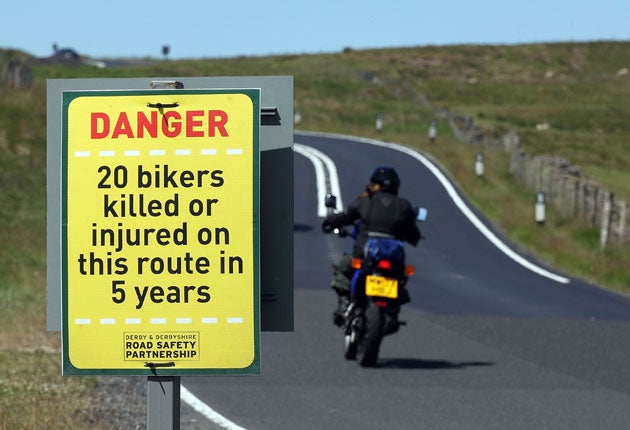Peak District route claims title of Britain's most dangerous road

A perilous 12km road running through the Peak District National Park has been officially named Britain's most dangerous highway.
The A537 from Macclesfield to Buxton in Derbyshire, dubbed the Cat and Fiddle, has seen crashes rise by 62 per cent in the past three years, with the equivalent of three fatal or serious injury collisions for every 3km stretch of road, according to a report by the Road Safety Foundation (RSF).
The 50mph single carriageway, which tourists are often forced to negotiate, takes in severe bends, steep falls and is edged by dry stone walls or rockface for almost all of its length. While the Cat and Fiddle comfortably tops Britain's 10 most dangerous routes, even without counting motorcycle crashes, the report found that drivers across the north-west and East Midlands have to negotiate the most hazardous roads in Britain, with particularly dangerous stretches in Bolton, Wakefield, Worksop and Nantwich. Routes in these areas are frequently rural and challenging to drive, with numerous blind corners and sweeping bends.
The RSF claimed that hundreds of deaths could be prevented with practical, inexpensive solutions, such as resurfacing and better road markings and signs. It said more than 300 people in the UK are alive today because just 15 roads have put such simple improvements in place.
On these 15 roads, fatal and serious-injury crashes dropped from 494 between 2004 and 2006 to 190 between 2007 and 2009.
The most-improved road is a 6.9-mile stretch of the A4128 from Great Missenden to High Wycombe in Buckinghamshire, where fatal and serious crashes went down from 19 to just two.
Dr Joanne Hill, director of RSF, said: "These are practical, largely inexpensive solutions which will pay back the costs of investment in an average of 10 weeks – a 500 per cent rate of return in the first year alone – and go on saving lives and saving money for the nation for many years to come. Much of this remedial work can be done as part of routine maintenance."
More than 30,000 people have been killed and 300,000 seriously injured in crashes on Britain's roads in the past decade. Britons are four times more likely to die on the roads than in any other daily activity. Road crashes remain the leading cause of death among young adults.
Dr Hill said that A roads remained the most dangerous routes. "While motorways and dual carriageways are moving towards the 'low risk' benchmark, the risk levels on non-primary single carriageway A roads in particular remain a cause for concern," she said.
Join our commenting forum
Join thought-provoking conversations, follow other Independent readers and see their replies
Comments
Bookmark popover
Removed from bookmarks